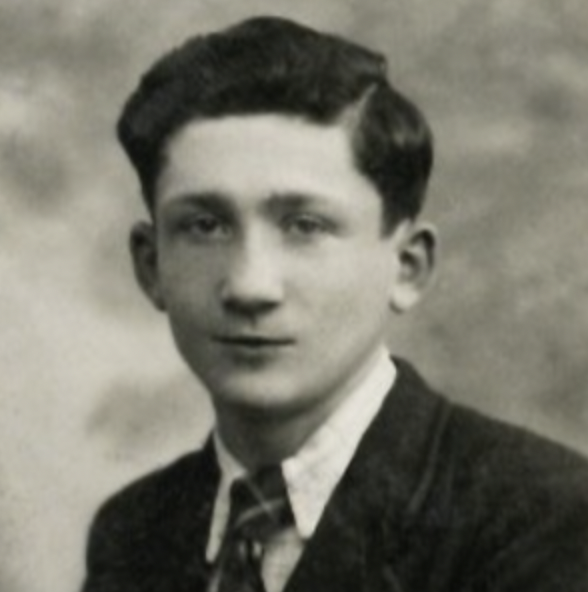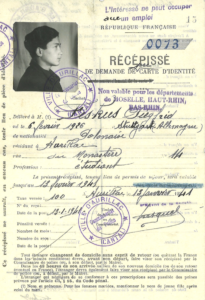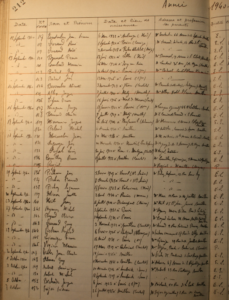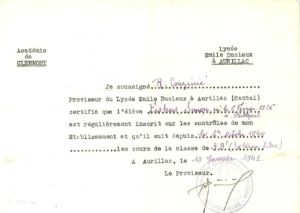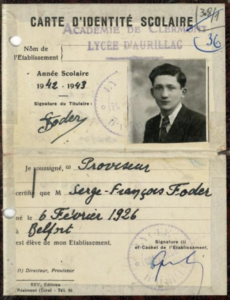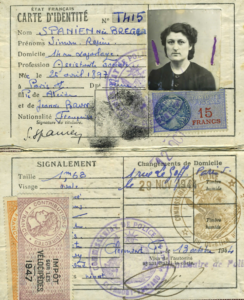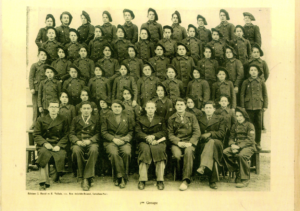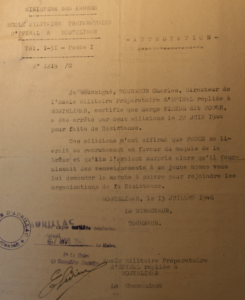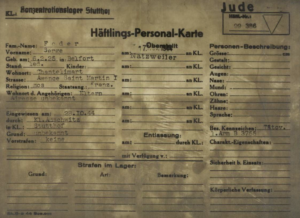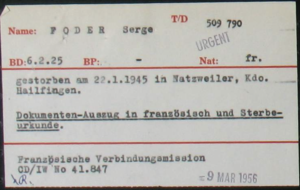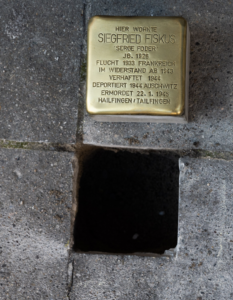Siegfried FISKUS, also known as Serge Foder
Born on February 6, 1926 in Stuttgart, Baden-Württemberg, Germany, Siegfried Fiskus was the second of three children. His parents, Leib Fiskus and Feiga Fiskus née Chajes, were both Polish citizens. Leib Fiskus was born in Dynów on April 22, 1896 and Feiga Fiskus was born in Lesko on October 26, 1897. These two small towns, which are approximately 37 miles apart, are both in Galicia, which was then on the eastern outskirts of the Austro-Hungarian Empire (and is now in the Podkarpackie voivodship in Poland)[1]. The couple left this area to move to the city of Stuttgart, in Germany[2] where they started a family. The Fiskus family emigrated to France in 1933. They settled in Belfort, in the Bourgogne-Franche-Comté region.
The family sought refuge in various places in France
Aurillac (in the Cantal department of France)
On June 18, 1940, German troops arrived in Belfort. According to the armistice agreements of June 22, 1940, the Territory of Belfort was in the reserved zone. The German presence there was more restrictive there than in other occupied areas, even though the department avoided being annexed as its neighboring areas in Alsace had been. The Fiskus family left their home at 7, rue du Petit Marché to seek refuge in the Cantal department in the Auvergne region. On June 26, 1940, the family had their identity cards stamped in Houade, a little hamlet over 3000 feet in altitude, which is in the municipality of Lascelle in the Mandailles valley. They were most likely sent there by the local refugees’ office. The town of Aurillac, the capital of the Cantal department, was about twelve miles away and it was only at the end of August that the family moved there. They initially stayed at 17 rue du Collège but a few weeks later they moved to 14 rue du Monastère, as shown on the acknowledgement of Siegfried Fiskus’ application for an identity card, which was issued by the prefecture of Aurillac in early 1941. Having previously been a fabric, clothing and hosiery salesman, Leib Fiskus began working again as a street trader in Aurillac.
Acknowledgement of application for an identity card, dated January 13, 1941. Source: Cantal archives, ref. l 3 SC 7 471
At the beginning of the 1940 school year, Siegfried Fiskus was enrolled in 9th grade at the Emile Duclaux high school in Aurillac.
Enrollment register from the Émile Duclaux high school for the year 1940.
Source: Cantal Departmental Archives, ref. 1 077 W 91
On the school certificate below, dated January 1941, the name Siegfried has been changed to Simon: might this be because Siegfried was a foreign-sounding name, and a German one at that? The name Simon was also used during the prize-giving ceremony at the Emile Duclaux high school for the 1940-1941 school year (Cantal Departmental Archives ref. 1 077 W 103). Oddly enough, however, at the end of the 1941-1942 school year, Simon became Siegfried again when the list of school prizewinners was published.
School certificate, Cantal Departmental Archives ref. 3 SC 7 471
At the beginning of the school year in October 1941, when Siegfried Fiskus was in 10th grade at the Emile Duclaux high school, his brother also started there, in 6th grade.
Meanwhile, in June 1941, a second decree on the status of Jews was enacted, increasing the scope of the first decree of October 3, 1940. The decree of June 2, 1941 broadened the definition of the term “Jew” that had been defined eight months earlier: It now included anyone of the Jewish faith who had at least two Jewish grandparents, as well as anyone of any faith who had at least three grandparents who were of the “Jewish race” and thus, according to the law, were themselves Jewish. This was deemed to be the case if they were not already members of any other church, and anyone who had converted after June 25, 1940 was still considered to be Jewish. The Fiskus family in Aurillac thus went from being foreign refugees to being foreign Jews.
List of names of Jews living in Aurillac on June 15, 194.. Cantal Departmental Archives ref. 1 W 153
On the list above, the names of Leib and Hella Fiskus as well as a mention of Fiskus without a first name, presumably Feiga, have been added in pencil at the bottom of the list. Siegfried and Moritz, who were younger, are not listed.
With the roundups that took place during the summer of 1942, the threat increased. On August 26, 1942, as was the case in many other places in the southern zone, the town of Aurillac was targeted and a number of Jews were arrested. Jacques Grelier, the new principal of the Emile Duclaux high school, who had succeeded R. Couzinié, helped the two brothers to obtain false identity documents. On the school identity card issued by the high school for the 1942-1943 school year, Siegfried Fiskus became Serge François Foder, born on February 6, 1926 in Belfort.
School identity card in the name of Serge Foder, school year 1942-1943
Busset (in the Allier department of France)
Hella Fiskus, his sister, was also in danger. With the help of a young rabbi, she made contact with a group of refugee students from the University of Strasbourg, who had fled to Clermont-Ferrand[3]. They managed to get her a false identity card that allowed her to travel around. While in Clermont-Ferrand, she also met Simone Spanien, who worked for the UGIF (Union Générale des Israélites de France or General Union of French Jews)[4]). She was the wife of Samuel Spanien, the lawyer who defended Léon Blum at his trial in Riom (February-April 1942. Simone Spanien found a safe haven for the Fiskus brothers in Busset, a town a few miles southeast of Vichy in the Allier department. An “old lady” took them in, according to Hella Fiskus, and according to the testimony by Maurice Fiskus in June 1960, she was a Mrs. Desfarges, a doctor’s wife from Busset. Hella Fiskus also took refuge there for a while. In her journal, Alice Ferrières[5], a young math teacher from Murat, who was involved in helping and sheltering Jews, mentions that in January 1943 “the two brothers were staying with a doctor’s wife near Vichy”[6].
Simone Spanien’s identity card, dated October 1944, from Sylvie Servan-Schreiber’s private collection
Simone Spanien lived at 14, rue Lagarlaye in Clermont-Ferrand. The premises was made up of an apartment on the second floor and two rooms on the sixth floor, one of which served as an office for her UGIF work and the other as a place for people passing through or for students. According to her daughter’s testimony, she provided fake identity documents for children, mainly Jewish children from Eastern Europe whose parents thought they would be safer in foster homes. Once the children had been given false identities, Simone Spanien published an advertisement in the newspapers entitled “Looking for a foster family”. She paid these families with UGIF funds, in the hope that if one day the families no longer received money to keep the children, they would have become attached to them and would still keep them safe (testimony of Denise-Ariane Spanien MacDonald, January 2021).
The situation in Aurillac was also far from safe for the Fiskus couple. In February 1943, Leib Fiskus was included in a list of foreign Jews to be arrested and sent to the Gurs camp. Although he had been declared “non-transportable” on February 28, 1943, because he had just had surgery at the hospital in Aurillac, he was not immune to arrest and internment in a camp for foreign workers. In March 1943, the Prefect of the region reminded the Prefect of the Cantal that “foreign Jews who could not be included on the convoys of February 25 and 26 due to sickness must be sent to a Foreign Workers’ camp as soon as they have recovered”. (Cantal Departmental Archives ref. 1 W 153 2). During the month of March, a Dr. Dupuy of Aurillac provided him with medical certificates stating that his medical condition required treatment at home and that he was unable to work (Cantal Departmental Archives ref. 10 W 235 and Puy-de-Dôme Departmental Archives ref. 900 W 63). Were these genuine or fake certificates? Either way, Leib Fiskus was not arrested.
Montélimar (in the Drôme department of France)
In September 1943, Siegfried Fiskus, still using the name Serge Foder, enrolled in the military training school in Épinal, which had been relocated to Montélimar, where he worked as a coach.
Class photo of the group 3 at the military training school. Siegfried Fiskus, alias Serge Foder, is seated in the first row, second on the right.
Who made it possible for him to be hired at this school? That question remains unanswered for the time being. During his stay in Montélimar, he was part of a resistance network. Did his resistance activity begin before he arrived there? Once again, the question remains open. The records kept by his sister contain letters from Michel Sanouillet, a sergeant in the FFI (Forces Françaises de l’Intérieur or Interior French forces), his network leader, which attest to his activities as a Resistance fighter[7]. This man knew him only as Serge Foder and did not know that he was Jewish. Then again, he did know that he was a member of the MNCR (Mouvement National Contre le Racisme or National Movement Against Racism). Might Siegfried Fiskus have been a communist? The MNCR was founded in the spring of 1942. This movement was intended as an ecumenical response to anti-Jewish persecution. It was an offshoot of the Jewish section of the MOI (Main d’oeuvre immigrée or Immigrant Workforce) led by Adam Rayski, and its objective was to alert the general public to the dangers of anti-Semitism for the nation, to encourage a movement of solidarity between Jews and non-Jews, and to encourage persecuted people to resist. Based in Paris, Lyon, Marseille and Nice, the movement was led by Lili Berger-Gronowski assisted by Léon Chertok, Simon Cukier and Jeanne Arrager-Oguz. It forged links with the Catholic hierarchy and Protestant circles and published two newspapers that reported on the abuses perpetrated in Eastern Europe: J’accuse in the northern zone and Fraternité in the southern zone. The organization took part in rescue missions for Jews. After the Liberation, it set up homes for Jewish children. In April 1944, Alice Ferrières mentioned in her journal that Siegfried Fiskus had come to see her in Murat in the Cantal department to ask her to produce propaganda for the MNCR. A letter from Captain de Lassus, head of the FFI in the Drôme department, also states that Serge Fiskus, known as Foder, was a member of the Secret Army[8].
Capitain de Lassus’ statement dated December 2, 1946, Cantal Departmental Archives ref. 2 258 W 19
Charles Tourneur’s statement dated July 13 1946, Cantal Departmental Archives ref. 2 258 W 19
On June 22, 1944, Siegfried Fiskus was arrested in Montélimar, under the name of Serge Foder. Depending on the source, he was arrested either by the Feldgendarmerie or by the Militia, and it was for his Resistance activities rather than because he was Jewish. According to a letter from Michel Sanouillet, he had been denounced. He was taken to the Fort Montluc prison in Lyon and then transferred to Compiègne. His family attempted to find out what had happened to him, and Hella Fiskus contacted Charles Tourneur, the principal of the military training school in Épinal, who replied to her on July 22 1944[9].
Charles Tourneur’s letter to Hella Fiskus dated July 22, 1944
Deportation
Drancy – Auschwitz – Hailfingen
Siegfried Fiskus arrived in Drancy camp on July 3, 1944. He was registered under the name of Serge François Foder. On July 31, 1944, he was deported to Auschwitz on Convoy 77. This transport included 1,310 people: 704 men and 606 women, and 324 children, most of whom had been rounded up by the SS, led by Alois Brunner, from the UGIF homes in and around Paris. When the convoy arrived, 291 men (B 3673 – B 3963) and 183 women (A 16652 – A 16834) were checked in and sent to the camp as prisoners. Siegfried Fiskus was one of them and was assigned the number B 3755. The other 836 people aboard Convoy 77 were killed in the gas chambers.
Thanks to Volker Mall, Siegfried Fiskus’ story as a deported worker in the Nazi camps is well documented. On October 26, 1944, he was on a transport that left the Auschwitz camp for the Stutthof camp near Gdansk with at least 75 other prisoners from Convoy 77. The numbers assigned to them in Auschwitz were between B 675 and B 935.
Stutthof camp prisoner record card in the name of Serge Foder
He was registered, still under his false identity, as having entered the Stutthof camp on October 28, 1944, where he was assigned the number 99386. His date and place of birth were noted as February 6, 1925 in Belfort. His address is misspelled, saying Chantelimart, Awence Saint Martin instead of Montélimar, avenue Saint Martin. On November 17, 1944, he was posted to an external camp, Hailfingen/Tailfingen. The words “Überstellt 17. Nov. 1944 Natzweiler” in the central column of his prisoner card confirms this. Tailfingen was a labor camp where, from 1941 onwards, prisoners of war and forced laborers were employed to expand and restore the airfield for night fighter planes, which had been constructed in 1938. In November 1944, an external kommando unit from the Natzweiler/Alsace concentration camp was established there. On Siegfried Fiskus, alias Serge Foder’s prisoner card, Natzweiler thus refers to Hailfingen. 601 Jewish prisoners from the Stutthof camp were transferred to the Hailfingen/Tailfingen camp, where they were forced to work in appalling conditions. There is evidence that 189 prisoners died there. Siegfried Fiskus died in Hailfingen on January 22, 1945, a few days before his 19th birthday, under the name Serge Foder. He was then listed as Serge Foder on the plaque commemorating the 75 deportees from the Hailfingen camp, which was inaugurated at the Tailfingen cemetery in 2010. When the plaque was replaced in 2017, the name of Serge Foder was used again.
Card certifying the death of Serge Foder
On March 4, 2022, a commemorative paving stone (stolperstein) was laid at Weimarstraße 15 in Stuttgart, the Fiskus family’s home when they lived in Germany. A memorial ceremony was organized by the Volker Mall Fund and was attended by Marc Genzel (Siegfried Fiskus’ nephew), his wife, Muriel Klein-Zolty and Pierre Caudrelier of the German-French Society.
Stolperstein in memory Siegfried Fiskus, photo taken by Marc Genzel on March 4, 2022
Sources
- Cantal Departmental Archives, refs. 1 W 153 1, 1 W 153 2, 7 W 372, 10 W 235, 1 077 W 91, 1 077 W 103, 2 258 W 19, 3 SC 7 471, 3 SC 10 190.
- Puy-de-Dôme Departmental Archives, ref. 900 W 63.
- CABANEL, Patrick, Chère Mademoiselle… Alice Ferrières et les enfants de Murat, 1941-1944, Paris, Calmann-Lévy/Mémorial de la Shoah, 2010.
- D’une mémoire à une autre, number 6, newsletter of the “Le Train de la mémoire” organization, May 2022.
- DOULUT, Alexandre, KLARSFELD, Serge, LABEAU, Sandrine, Mémorial des 3 943 rescapés juifs de France, Paris, The Beate Klarsfeld Foundation/FFDJF/Après L’Oubli, 2018.
- MALL, Volker, Die Häftlinge des KZ-Außenlagers Hailfingen/Tailfingen, Bad (Books on demand), 2014.
Notes
[1] Although they were both born in the Austro-Hungarian Empire, the Fiskus couple became Polish citizens following the signing of the Treaty on the Recognition of the Independence of Poland and the Protection of Polish Minorities on June 28, 1919.
[2] Research to date has not revealed the date on which the couple arrived in Germany.
[3] On November 23, 1939, the seven faculties of the University of Strasbourg moved out of Alsace to the Auvergne region, at the University of Clermont-Ferrand.
[4] The UGIF (Union générale des Israélites de France or General Union of the Jews in France) was founded, at the request of the Germans, by a French government act of November 29, 1941, published in the French Official Gazette on December 2, 1941.
[5] Alice Ferrières was the first woman in France, and the 83rd in the world, to receive the title of Righteous Among the Nations awarded by the Israeli Institute Yad Vashem on July 28, 1964. She was the second person in France to receive this title after Father Jean Fleury, who had been recognized as Righteous Among the Nations the previous year.
[6] CABANEL, Patrick, Chère Mademoiselle… Alice Ferrières et les enfants de Murat, 1941-1944, Paris, Calmann-Lévy, 2010, p. 444.
[7] Born in 1924 in Montélimar, Michel Sanouillet joined the Resistance in 1942. After the war, he began his research on the avant-garde movements of the 20th century. An art historian and academic, he became an expert on the Dada movement, and wrote numerous articles and books on the subject.
[8] Founded in the autumn of 1942, the Secret Army brought together the paramilitary forces of the three main movements in the southern zone (Combat, Libération-Sud and the Franc-Tireurs). Initially, it was a part of the Mouvements Unis de la Résistance (United Movements of the Resistance), officially founded in January 1943 under the leadership of Jean Moulin, but it did not yet include the forces in the northern zone. In April 1943, the paramilitary forces of the main movements in the northern zone also joined the Secret Army, which from then on covered the entire country. Although an agreement had been reached between the Communist Party and France combattante (Fighting France), the Francs-Tireurs Partisans maintained their autonomy. In February 1944, the Secret Army merged with the Forces Françaises de l’Intérieur (French Interior Forces).
[9] it is worth noting that the letter is addressed to Hélène Foder [rather than Hella Fiskus].


 Français
Français Polski
Polski